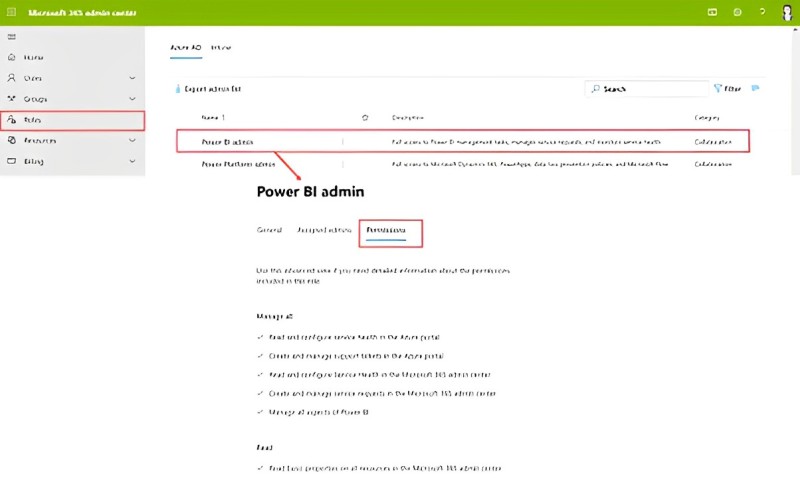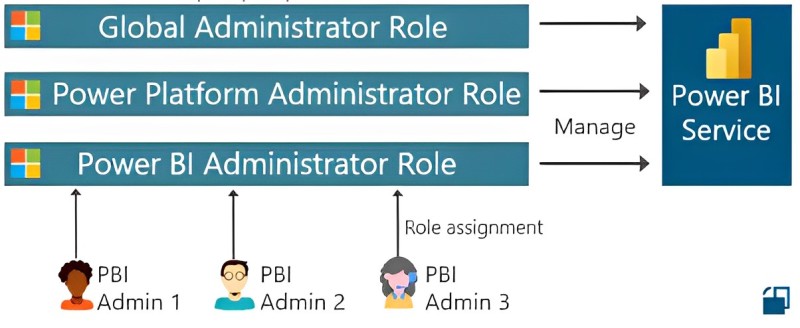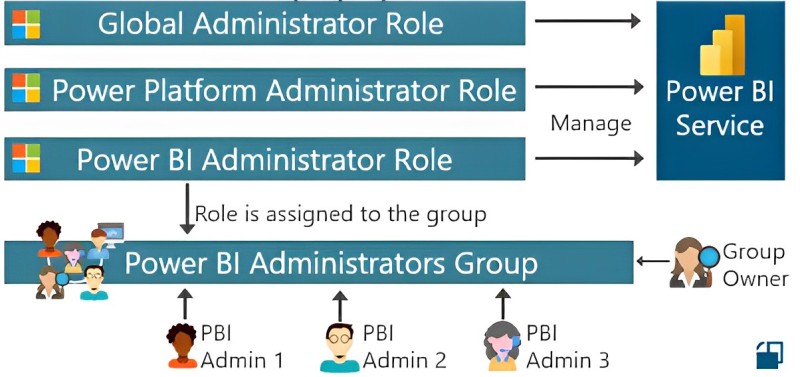Struggling to Share Relevant Power BI with Azure Insights While Managing Access Risks?
Azure AD Integration Holds the Keys

Empowering data-driven decisions requires getting meaningful analytics views to many cross-functional teams for impact.
But how do you maintain prudent restrictions preventing sensitive data overexposure?
Passport to resolution lies with thoughtfully structuring Azure Active Directory administrative roles and access levels.
Let’s explore key considerations for maximizing analytic tool usefulness without compromising data governance.
Centralizing valuable company data assets into unified reporting tools like Power BI development services drives immense value unlocking enterprise insights not possible by gathering disparate departmental perspectives alone.
However, organizations also carry duties protecting information assets through appropriate identity and access frameworks securing what matters most.
Harnessing the native integration between Power BI and Azure Active Directory allows administering permission policies mapping groups to appropriate data view levels managed through single unified interfaces.
Appropriately scoping access prevents excessive exposure risks across vast employees while still granting adequate visibility where needed for roles.
Just as intricate keys unlock doors, configuring AAD opens data insights broadly while protecting data keys.

1) Classify Sensitive Data and User Groups
Before defining technical access specifications, first conduct contents and user assessments framing scope across two dimensions:
Classify Data Categories
Inventory reporting content and data sources feeding unified models categorizing sensitivity levels.
Certain financial figures, customer details, and IP-protected concepts require tighter access restrictions than general companywide messaging for example.
Categorize Consumer Groups
Identify the spectrum of teams interacting with analytics capabilities based on role needs – executives setting top-down strategy, business operations monitoring daily KPIs, finance controlling spending, human resources tracking talent indicators, etc. Map groups to data categories required for their function.
Overlaying data sensitivity checklists to user group access requirements matrices highlight alignment gaps needing permissions customization between what teams need to see versus current level overexposure risks given the confidentiality levels involved.
For example, company finance consolidating general sales revenue reporting for investors requires access to figures from all regions.
But drilling into discount rates or account manager bonus payouts poses undue risk beyond essential needs.
Such visibility mismatch signals the need for more granular scoping.
Regular cross-checks between evolving data assets and changing team mandates refine permission needs over time. Central clarity upfront streamlines the next steps.
2) Structure Azure Access Hierarchies

With target content protection and access scope framed, configurable Azure constructs determine how insights flow securely across the organization. Core building blocks include:
Directory Administrative Roles
The Azure directory houses user identities and configures administrator privileges managing resources. Key roles include:
- Global Admins – Highest plane access provisioning users/groups and services
- BI Service Admins – Manage Power BI capabilities specifically like dataset and dataflow lifecycle
- User Admins – Maintain user profiles and group memberships
Balance centralized IT controls through Global Admins overseeing BI focus areas delegated through Service Admins enabling agility at scale.
Security Groups
Admin roles focus on what users can do while security groups align to what content they access.
Groups logically organize users like “Sales Leadership” or “Northwest Retail Managers” representing business units matching data view needs. Groups then connect to assets through access roles in the next tier…
Access Roles
These permission levels tie groups to assets securing data aligning with member responsibilities. For Power BI Developer, common roles include:
- Admin – Full asset control like workspace creation and data set deletion
- Member – Interactive content use like dashboard editing and subscription
- Contributor – Can publish/share new reports but not delete
- Consumer – Read only consumption of final artifacts
3) Implement Access Governance
With identity architecture objects covering administrative control points, customizable access levels, and dynamic groups defined, applying governance practices sustains balance enabling broad sharing with responsible oversight:
Develop Data Access Review Cycles
Schedule periodic reviews validating group access alignments to current data and system privileges needed.
Refresh group compositions moving people across business units and roles. Revise permission levels per evolving regulations. Frequent checks prevent privilege gaps or creep.
Automate Access Provisioning
Use tools like Azure AD entitlement management automating access role assignments and review alerts based on attributes like user location.
Machine learning recommends privilege escalations or revocations tied to risks. Reduce manual errors enabling adaptive responses to workforce shifts.
Embed Access Reviews into Business Processes
Integrate access certification workflows into regular business cycles like employee onboarding/offboarding, project kickoffs requesting data needs, finance audits, etc.
Programmatically trigger reviews rather than just manual calendar reminders falling through the cracks after some time.
Analyze Permission Patterns for Insights
Leverage capabilities like Azure AD access reviews and Power BI usage metrics analysis exposing trends on typical access behavior like failed sign-ins, rights utilized versus dormant, and suspicious permission escalations.
Quantify risk profiles guiding policy priorities for heavier restrictions.
The balance between access and security evolves continually across an enterprise information landscape.
Establishing governance systems sustaining equilibrium in motion is key.
4) Monitor, Notify and Enforce
Closing the loop on effective access oversight requires ongoing visibility into how policies translate into actual adoption.
Power BI predictive analytics and alerts help policies scale across expanding users, data, and permissions:
Build Access Audit Reports
Using tools like Azure Monitor digest activity for PBI assets including administrator actions like member additions and permission changes.
Helps identification of risk areas needing reviews like numerous failed sign-ins or spikes in denied content attempts.
Configure Alerts on Red Flags
Extend monitoring into proactive notifications by configuring log search alerts around key detections like suspicious IP locations associated with sign-in attempts or repetitive access denials signaling misconfigurations needing remediation.
Trigger Automated Policy Enforcement
Take action guardrails a level further through tools like Azure Policy applying automatic controls blocking non-compliant access attempts or quarantining risky user behaviors for investigation.
Codify organization rule boundaries enforcing properly scoped sharing by default.
Report Metrics to Leadership
Roll up access and security analytics into management views like Power BI dashboard development conveying wider trends on adoption, risks, and access optimizations engaging decision makers’ priorities beyond just IT and Security.
Provide navigators with ongoing stewardship clarity for major initiatives.
Providing adequate access delivers little value if not aligned with business goals responsibly.
Quantifying protection risks focuses on important tradeoff dialogues balancing discoverability with prudent data constraints.
5) Incorporate External User Access
While managing internal information access scopes poses enough governance challenges, today’s ecosystem of partners, vendors, and customers requires collaboration access to further complex permissions.
Here are a few ways to securely embed external identities:
Utilize Access Packages for Temporary Access
Instead of granting permanent credential access, provide finite access periods allowing temporary data exploration like limited window vendor analytics needed while developing a sales tool integration.
Confine via start and end dates combined with MFA conditional access policies for enhanced security.
Create Dedicated Guest Accounts
To handle partners requiring deeper application access like supply chain inventory visibility, create distinct guest accounts within Azure AD tied to specific external secondary domains.
Maintain full audits even after completion through inactive account reporting. Require sponsorship linkage to internal employees owning the relationships.
Publish Curated Snapshots into Azure SQL
Rather than opening bandwidth across entire datasets which risks exposure even under strict roles, publish targeted read-only filtered data extracts into Azure SQL accessed through limited secondary accounts or even anonymous guest querying if analytics needs required.
Redact sensitive attributes. This balances external sharing safely but still encourages value co-creation.
Utilize Azure Data Share Invitations
Azure Data Share extends one-time extracts into ongoing publish-subscribe data updates with external teams under revocable terms and defined interval guardrails between refreshes for more interactive sharing like collaborative analytics projects. Maintain compliance even across fluid use cases.
6) Promote Responsible Data Culture
Technical access controls alone still depend on human discretion avoiding improper data use like querying only minimum details necessary for a task. Reinforce cultural wisdom through ongoing learning:
Start with Securing Identities
Reduce risks of compromised access from phished credentials or password leaks by enabling MFA policies along with access review cycles validating legitimate business needs and staying current.
Access starts with valid identities so strengthen sign-in risk detection through Azure AD Identity Protection.
Maintain Transparent Policies
Clarify what data roles can access through user-friendly handbooks, unambiguous labeling schemas on reports, and sedimented training content so no excuses like “I didn’t know” exist violating policies.
Prominently publish contacts for airing ambiguous cases requiring guidance upfront.
Incentivize Responsible Access
Gamify access practices through dynamic leaderboards awarding points for successfully passing access certification tests annually.
Celebrate teams and individuals demonstrating repeated stewardship excellence through behaviors like properly scoping queries to minimum requirements or notifying authorities of suspicious activities noticed.
Learn from Incidents
Rather than focusing on blame for improper data retrieval incidents, leverage constructive forums performing root cause analysis on conditions enabling policy violations.
Revise protocols to minimize future recurrence through technology checks, process controls, or policy clarifications without discouragement hampering judgment calls.
7) Sustain Governance Scalability
With policies and culture nurturing responsible access taking shape, turning attention to scalable governance sustaining hygiene helps accommodate exponential usage growth:
Automate Recertification Campaigns
Rather than just running one-off access reviews, build machine learning algorithms auto-detecting changes in user behaviors or business contexts to trigger dynamic reviews saving manual evaluating cycles only for dimension shifts detected vs fixed periodicity.
Structure Data Lineage Hierarchies
Implement hierarchical data classification categories not just binary sensitive vs non-sensitive to guide appropriate access gradients across zones like Highly Confidential > Confidential > Internal > Public.
Cascading classified metadata means downstream inheritance retains governance automatically.
Shift Left Policy Integrations
Starting with service tickets requesting new data access, programmatically embed mandatory policy checks before provisioning.
Shift left validation reduces change cycles over waiting until after deployment then needing revocation if finding unauthorized exposure.
Engineering first-time governance speeds delivery.
Report Automation Analytics
Digest access change trends through Power BI consulting monitoring usage spikes across permissions, data categories, and user groups.
Guide policy priorities examining where governance controls instill the greatest protection for increasing risk areas over time.
Let data direct manual oversight efficiency.
Developing governance capacities and maintaining cleanliness at scale allows humans to focus on more subtle issues such as ethical data use cases rather than monotonous rule enforcements that can be computed using cutting-edge algorithms.
8) Architect for Regulatory Compliance
In regulated industries like healthcare and financial services, stringent governance requirements mandate capabilities explicitly designed to meet standards like:
Implement Native Capabilities Aligning Controls
Utilize built-in Azure Purview and Power BI sensitivity labeling, column-level security, row-level security, and dynamic data masking meeting mandates like HIPAA protecting private health information (PHI).
Proactively address gaps early preventing last-minute fire drills from failing external oversight.
Develop Insights across Surveillance Data Expand security analytics ingesting streams beyond access logs to endpoint detections like malware events, multi-factor authentication logs, and Microsoft Dynamics 365 CE content access.
Connect dots across signals pinpointing risk interdependencies missed in isolated assessments.
Maintain Traceable Change Records Log all provisioning tickets, model/code revisions, and policy amendments managed under proper Git version control procedures detailed with approver names, timestamps, and artifacts affected.
Immutable histories speed threat investigations and protect from malicious actors internally.
Weaving compliance directly into system design prevents reactive scrambles attempting to reverse engineer controls after infractions or audit failures.
Take proactive command optimizing configurations
Balancing governance scalability sustaining security and compliance while still encouraging access velocity feels like a never-ending battle.
However, the right blend of automated policy guardrails, risk quantification, and culture building reinforces responsible access as data asset value continues to compound exponentially over time.
What creative data access solutions have you devised that might provide additional inspiration to readers on their governance journeys?
Please share any hard-earned lessons or governance capability wish list items that would better empower teams while providing air-tight data protection!
Read more:



